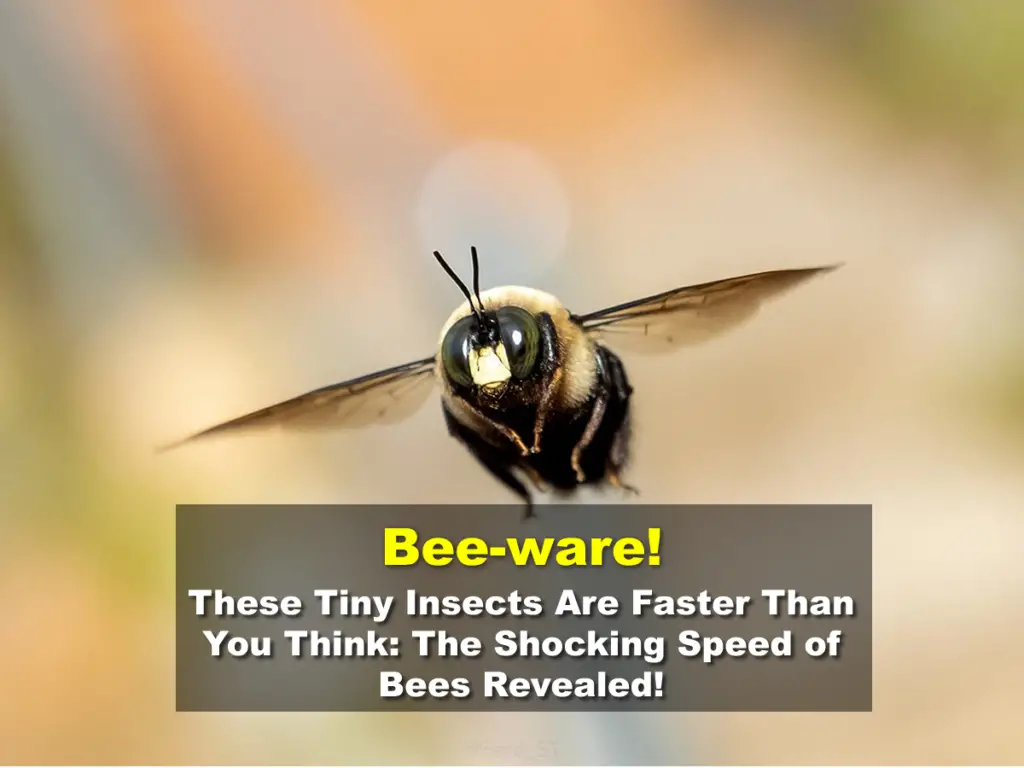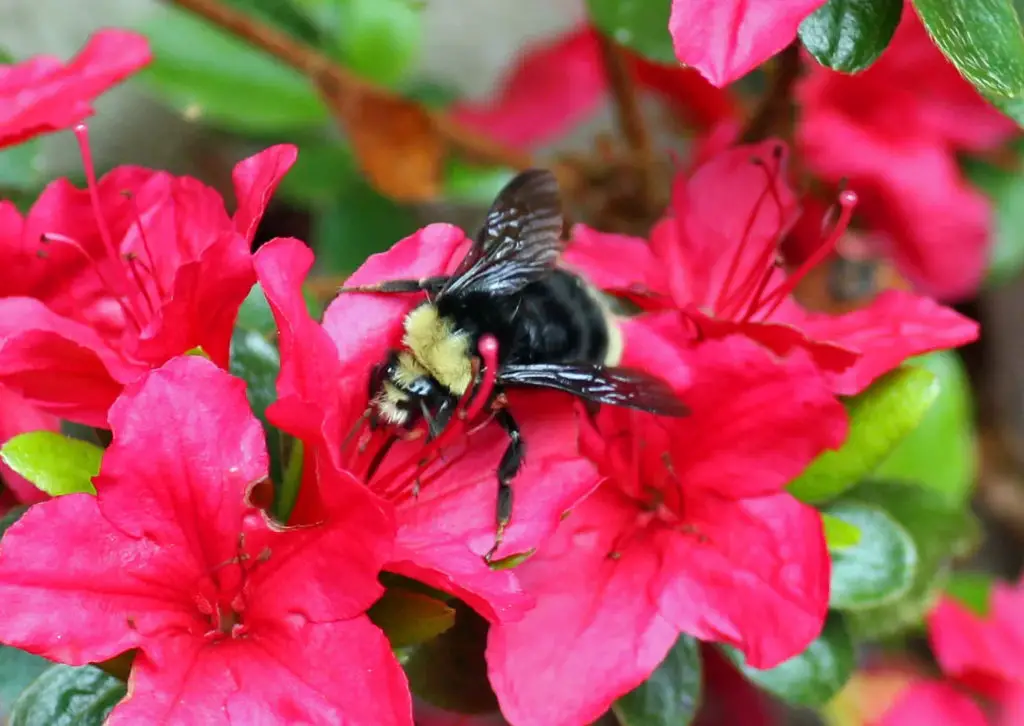Affiliate Disclaimer - As an Amazon Associate I earn from qualifying purchases.
It supports the website. So, Thank you
Have you ever watched a bee buzzing around your backyard? They move pretty quickly, don’t they? But this got me wondering how fast can bees fly?
Honey bees usually fly between 12 and 15 miles per hour although they are able to fly a little faster than this when needed. However, different species have evolved to fly at different speeds.
It’s all to do with the work that the bees do. For example, bumble bees do not have as many tasks to complete as honey bees. Plus, they’re not as aerodynamic.
In this post, I’m going to be exploring the flight speeds of different types of bees and looking at how they move around in the air.
Table of Contents
The Dynamics Of Bee Flight
I’m totally amazed by bees and everything they do and that includes how they fly. Before I get into the figures of bee flight speed, I thought it would be useful to talk a little about how bees fly. The dynamics of bee flight vary between species and this has an effect on how quickly they can fly.
- The wing structure of the bee plays a role in how they fly. Bee wings are made from a very thin membrane which also has a vascular system running through it. The structure of the wings means that they can either be flexible or rigid depending on the current needs. There are two pairs of wings; forewings and hindwings which are connected to one another which allows them to work together for better coordination. In this, this means the bee can get the thrust and lift it needs to take flight.
- The muscles of the bee are also essential during flight and they have two primary sets which are located in the thorax. These are known as the direct and indirect flight muscles. The latter is seriously powerful and provides the energy needed for the bee to flap its wings. The former is used to control things like wing rotation and angle which allow the bee to move around more accurately.
- Generally speaking, a bee will beat its wings between 200 and 250 times a second and this is what creates the lift needed to get them into the air. But this isn’t enough to maintain flight so they need to couple this beating with flight techniques such as using a figure of eight movement as they beat their wings.
- You might have noticed that bees fly quite quickly at times and then slow down and this is part of the intricacy of their flight. They’ll adjust their speed according to their current needs. When they’re foraging, they’ll fly much more slowly but when they’re heading back to the hive or trying to escape a threat, they’ll speed up.
How Fast Are Honey Bees?
Honeybees are among some of the fastest-flying bee species out there and usually fly at around 12 miles per hour. However, they are capable of reaching speeds of between 15 and 20 miles per hour when they need to.
How Fast Are Carpenter Bees?
Carpenter bees are a little slower than honey bees but they do have an extremely powerful flight. At their maximum, these common bees can reach speeds of up to 7 miles per hour.
How Fast Are Bumblebees?
Bumblebees are incredibly common in gardens all over the world and they’re known for their fuzzy appearance. However, because of their shape and size, they’re not able to fly anywhere near as quickly as a honey bee and typically don’t exceed speeds of 3 to 6 miles per hour.
How Do Bumblebees Maintain Flight?
The interesting thing about bumblebees is that they don’t look as though they’d be able to fly at all. Those fuzzy, round bodies of theirs can get very large, especially in comparison to the size of their wings.
When we think of things that can fly, we imagine aerodynamic and streamlined objects such as an airplane, or indeed, a honey bee. The bumblebee simply doesn’t fit into this so how exactly does it maintain a stable flight?
While they’re not the quickest bees in terms of flight, bumblebees have other traits that help them navigate the world from the air. Scientists have confirmed that, as opposed to being aerodynamic, bumblebees use brute force to remain in flight. A diet of nectar provides them with a lot of energy while a large thorax helps the bee to move through the air. Although, according to research, this does reduce the efficiency of their flight.
What Determines How Fast A Bee Flies?
There are several things that affect the speed of any given bee and it’s important to consider these when we’re looking at how they fly.
- The species of the bee determines how quickly it flies and this is all down to the shape and size of the bee as well as the structure of its wings. We have already seen that bumblebees are much slower simply because of their size and shape.
- The local conditions can have an effect on how fast a bee can fly. This includes things like wind, humidity, and temperature but I will look at how the weather affects bees’ flight in more detail later in this article.
- As I mentioned earlier, you’ll have seen bees speeding up and slowing down depending on their needs. When they’re trying to escape a predator, for example, flying at a higher speed gives them greater agility.
- The age of a bee also plays a part in how quickly it can move. As they get older, they’ll have sustained damage to their wings which may become worn and this affects their ability to fly as quickly.
- How often a bee beats its wings also has an effect on its flight speed. Again, the bee’s capability for beating its wings quickly largely depends on its species. For example, honeybees have some of the fastest wing-beating speeds of up to 250 times per second. On the other hand, those chunky bumbles don’t beat their wings anywhere near as quickly which is another reason they can’t fly as fast.
Does The Weather Prevent Bees From Flying?
Earlier, I touched on the fact that environmental conditions can affect how quickly or easily bees can fly. You may have noticed that, on an overcast or breezy day, you see fewer bees than would when the conditions are still and sunny. There’s a reason for this and while bees are robust little creatures, they can be sensitive when it comes to the weather.
Temperature
Bees are ectotherms. This essentially means that they cannot regulate their own body temperature and rely on external factors to keep warm. This often comes in the form of being in full sun and, in the hive, they’ll huddle together.
However, if the external temperature isn’t high enough, bees tend to remain in the hive which is why you don’t see as many of them.
On the flip side, conditions can be too warm for the bees to fly and this is one of the primary factors that affect their speed. Once it gets much past 95ºF, the bees struggle to maintain high speeds so you’ll see them moving around much more slowly.
Wind
Wind may positively or negatively affect the flight speed of a bee. In some cases, it may assist them by moving them along but in other situations, it can seriously hinder their ability to fly.
When bees leave the hive to forage, they will normally fly against the wind. This means that, when they return, the wind will push that back more quickly so they can take their precious cargo to safety. However, if the wind is very strong, this makes the bee lose its speed and stability.
Once wind speeds get to around 15 or 20 miles per hour, you’ll find that most bees will avoid leaving the hive altogether.
Humidity
Most bee species are pretty aerodynamic, apart from the bumblebee, and this means that they need the air to be easy to fly through. When it is humid, the air becomes more viscous and therefore puts up more resistance to the bee, slowing it down.
This means that they have to use up more energy when flying which is again why you may not see as many bees when it’s very humid. Moderate humidity levels provide optimum conditions for bee flight as anything too low can result in dehydration.
Rain
Flying in the rain is not only difficult for bees but it can be downright dangerous. When it’s raining or there’s any other form of precipitation, it’s very unlikely that you’ll see bees out and about. This is because, when they get wet, they become weighed down and this makes it incredibly difficult for them to remain in flight.
What’s more, being wet means that it’s not as easy for their wings to create the lift needed to remain in the air.
Help! A Bee Is Chasing Me; Can I Get Away?
One of the main reasons that a lot of people want to know how quickly bees can fly is to understand whether they could outrun one should they ever need to.
Normally, bees aren’t interested in people and they certainly won’t chase you for no good reason at all. The only time that bees usually become aggressive is if they feel threatened. This might be if you are swatting at them, are too close to their hive or are interfering in what they’re doing.
One of the major problems with honey bees is that, when one bee feels threatened, it will emit a pheromone that alerts other members of the colony. This can result in you being chased by several bees. Since honey bees can fly at up to 20 miles per hour, it would be difficult to outrun one.
The best thing to do is just allow any bees that visit your garden to get on with what they’re doing. Once they’ve finished foraging, they’ll fly off and everyone will be happy.
The only time that I would say it’s right to worry about a bee chasing you for no reason is if you are faced with Africanized honey bees. This is a species that is known for its aggression and individuals may sting for no reason.
Final Thoughts
How fast can bees fly? This all depends on a number of factors such as the species, the body shape, the wings, and even external factors like the weather. Some bee species, like the honey bee, can reach very high speeds of up to 20 miles per hour while the bumblebee is much slower because of its larger, less aerodynamic shape.
In any case, the flight of a bee is one of the most fascinating things about these creatures and, when you have the opportunity, it’s well worth observing them as they fly about your garden.




